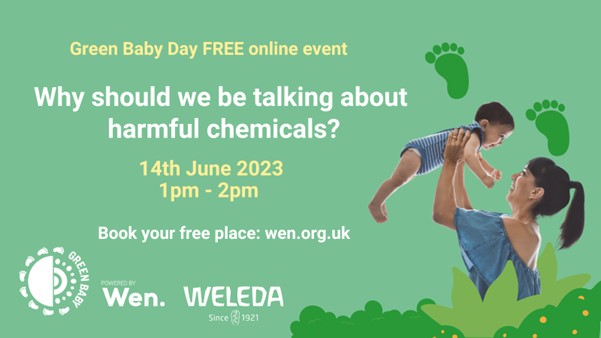 The Women’s Environmental Network (Wen) is launching the first ever Green Baby Day on 14 June, sponsored by Weleda. The day of action calls for a sustainable and toxic-free future for babies and children, their parents and carers.
The Women’s Environmental Network (Wen) is launching the first ever Green Baby Day on 14 June, sponsored by Weleda. The day of action calls for a sustainable and toxic-free future for babies and children, their parents and carers.
Green Baby Day aims to provide information to help families make healthy, eco-friendly and affordable choices to minimise exposure to harmful chemicals, and focuses attention on the need to ensure effective chemicals regulation to protect current and future generations, especially post-Brexit1.
Join the free online discussion ‘Why should we be talking about harmful chemicals?’ on 14 June from 1-2pm with guest speakers Charlotte Brody, National Director for Healthy Babies Bright Futures and Vice President for Health Initiatives of the BlueGreen Alliance, together with Wen’s expert scientific researcher Helen Lynn, and Weleda’s Skincare Expert Elizabeth King, to find out why we should be concerned about toxic chemicals in everyday products and what we can do to reduce our exposure.
Why Green Baby?
Exposure to toxic chemicals and pesticides is a feature of everyday lives in our homes, workplaces and in the wider environment. There are tens of thousands of chemicals in regular commercial use, many with little health and safety information, with the potential to harm our health, our fertility, the health of our children and future generations2. Children are particularly vulnerable, but to the developing foetus even small exposures can have serious and lifelong health consequences especially at specific times during pregnancy3.
Prebirth or early life exposure to certain chemicals has been linked to a range of diseases including cancer, birth defects, fertility, developmental, neurological, and immune disorders4. Harmful chemicals can adversely impact our respiratory, reproductive, cardiovascular and urinary systems, and disrupt our endocrine system (our body’s network of hormone producing organs and glands, controlling all our vital functions from growth and development, to metabolism and reproduction).
These chemicals and even microplastics from consumer products have a nasty habit of ending up where they shouldn’t. Recent examples include microplastic in baby poo5 and 109 toxic chemicals such as flame retardants, cosmetics ingredients, and plasticisers found in maternal and umbilical cord blood, including 55 that had never been found in people before6.
Even everyday cleaning products like laundry detergents can release harmful air polluting chemicals in the form of Volatile Organic Compound (VOCs) – linked to asthma, cancer and developmental harm7. Hormone-disrupting chemicals such as Bisphenols have been found in 60% of 121 children’s products tested including baby blankets, baby bottles or sipping cups, and teething toys8. And ‘forever chemicals’ such as PFAS can affect foetal and maternal health9.
It has also become increasingly difficult to conceive initially with sperm counts more than halved in the last 40 years – a decline of 60 per cent since 197310. Women have experienced a significant increase in impaired fecundity (the ability to have children); unfortunately, this is not restricted to older women, as the largest increase is younger women11. This has been linked to many of the harmful chemicals.
This is all compounded by where you live. Poor housing, air pollution, unsafe workplaces and other socio-economic factors impact the survival of children.
Green Baby campaigner Helen Lynn reflects: “Post-Brexit, the transposition from the gold standard European chemicals regulation REACH means many of the safeguards in place to protect health and environment are up for discussion. England and the citizens of the devolved governments deserve a strong UK REACH, and we need to let our politicians know this.”
Linda Tai, Wen’s Green Baby campaign manager, called for safer chemicals regulation so that “parents and carers can exercise their right to a healthy environment to bring up their children. The children of tomorrow have the right to a clean and sustainable environment to grow and develop”.
For more details about Green Baby Day and how you can get involved, go to www.wen.org.uk/greenbabyday
References
1 12 Key Priority Asks https://allianceforcancerprevention.org.uk/2021/05/11/12-key-priority-asks-for-the-uks-new-chemicals-strategy/
2 Skinner, M. Endocrine disruptor induction of epigenetic transgenerational inheritance of disease. Molecular and Cellular Endocrinology 398 (2014) 4–12
3 Rolfo, f et al. Fetal-Maternal Exposure to Endocrine Disruptors: Correlation with Diet Intake and Pregnancy Outcomes. Nutrients. 2020 June 11; 12(6): 1744.
4 The Endocrine Society. 24 Jan 2022. https://www.endocrine.org/-/media/endocrine/files/patient-engagement/hormones-and-series/hormones_and_edcs_what_you_need_to_know.pdf
5 Zhang, J et al. Occurrence of Polyethylene Terephthalate and Polycarbonate Microplastics in Infant and Adult Feces. Environmental Science & Technology Letters 2021 8 (11), 989-994.
6 Wang, A et al. Suspect Screening, Prioritization, and Confirmation of Environmental Chemicals in Maternal-Newborn Pairs from San Francisco. Environmental Science & Technology 2021 55 (8), 5037-5049.
7 S LaMotte. Over 5,000 tons of dangerous fumes escaped from consumer products, study finds. CNN May 2nd 2023.
8 S Muller. Hormone-disrupting chemicals found in 60% of 121 children’s products. BEUC. May 31st 2023. https://www.beuc.eu/blog/hormone-disrupting-chemicals-found-in-60-of-121-childrens-products/
9 Statement from Figo: FIGO calls for removal of PFAS from global use. 25th May 2021. https://www.figo.org/figo-calls-removal-pfas-global-use
10 Levine, H. Temporal trends in sperm count: a systematic review and meta-regression analysis of samples collected globally. Human Reproduction Update, Volume 29, Issue 2, March-April 2023, Pages 157–176, https://doi.org/10.1093/humupd/dmac035
11 Shanna Swan. Count Down. Published Scribner, New York 2021.













Read our latest issue
Latest News
His Majesty The King becomes new Patron of RPS
New report highlights collaboration to enhance workforce wellbeing
incognito launch sustainable bracelet that repels insects
Lutein and zeaxanthin contribute to children’s eye and brain health
Latest Tweets